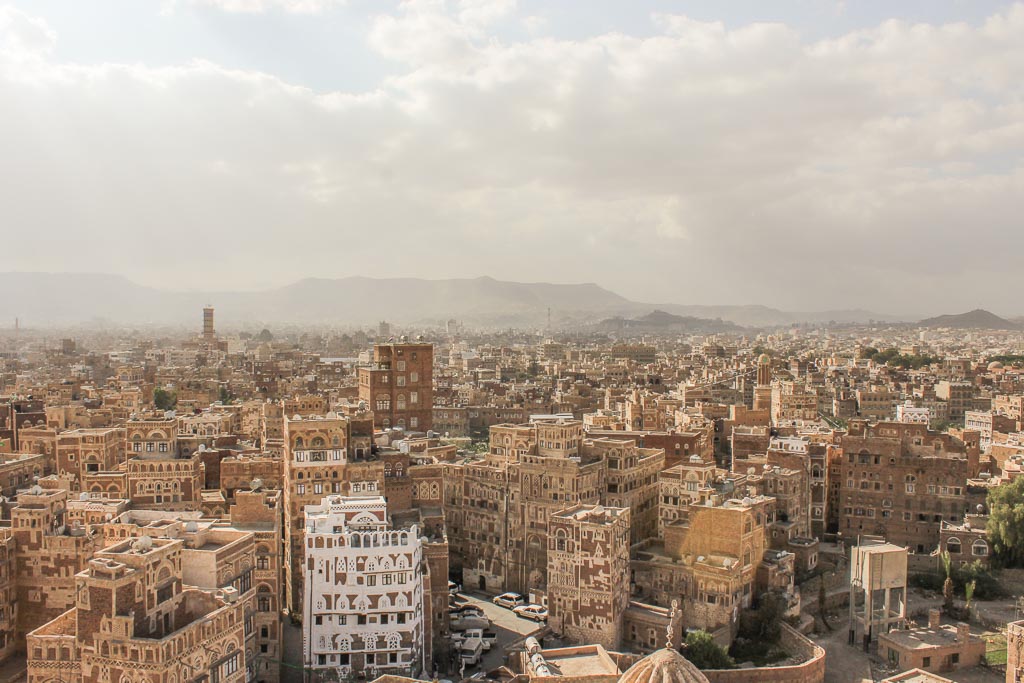
Visiting Sana’a Yemen, A Travel Diary
Updated April 2024, Visiting Sana’a, Yemen, A Travel Diary was originally written in September 2015
It was early in the morning, January 31st, 2014. I sat at my gate at the Dubai Airport in my long black dress and hijab, with my hands slightly shaking, clammy, and clutching my boarding pass to Sana’a and a paper copy of my Yemeni visa.
Would I be kidnapped by a tribe and held for ransom to build a school or road? Would I be kidnapped by Al-Qaeda and most likely beheaded*? Or would I come home unscathed? I mean really, who in the right mind decides to travel to Yemen?
*After all, the US government doesn’t barter with terrorists, unless of course, it involves trading 5 known terrorists for the release of the precious Bowe Berghdal.
I was already playing it out in my head: The ridiculous comments people would write on the article explaining my disappearance while vacationing in Sana’a. Like how I deserved to die for going there, and how stupid I am to travel to Yemen, or how much of an asshole I am for expecting the American government to bail me outta there.
Believe it or not, I don’t think the ‘US government’ has an obligation to bring me home, and I do think that if they were to evacuate me, I should probably be billed for it considering I made the conscious decision to go there even with an understanding of the volatility, instability of acting government, the warring tribal factions, and a long-standing Al-Qaeda presence. Anymore, people feel highly inclined to voice their slighted and unfounded opinions online from the safety of their own couch where laziness and poor health decisions are a far likelier risk of death than a potential terrorist attack.
The announcement came across the PA system. They were boarding my row.
But, but… I had been eyeballing Yemen for years at this point, close to a decade actually. I was so close to Yemen and its alien island of Socotra. I wanted this. I had wanted to travel to Yemen for a long time. Two days ago I left home, 3 days ago I was at my Grandmother’s funeral, 4 weeks ago she was insisting I book my ticket to Sana’a.
I still had mere seconds to back out. The line got closer to the counter.
I could book another ticket out elsewhere, somewhere that didn’t have any advisories saying to stay away for non-essential travel. You’ve never been to the Middle East before Nicole, and you decide to travel to Yemen of all places?
I noticed a group of three backpackers (who I’d find out later when I ran into them in Socotra had come from Hong Kong) that looked to be about my age. I felt a little more at ease knowing I wasn’t the only foreigner headed to Yemen. Beep. She scanned my ticket and checked my visa, “Thanks Ms. Smoot, enjoy your flight to Sana’a.”
This was the trip that almost didn’t happen. I had been scouring the internet, looking at photos of Yemen and Socotra for a few years after reading some articles with an obscure list of destinations to visit, and Socotra was what caught my attention more than anywhere else on it. I dug further down the rabbit hole.
I figured out Socotra was technically part of Yemen. I looked at photos of Yemen, I became fascinated by the sand block buildings with gypsum icing adorning them. I knew I had to see it for myself eventually.
I booked my ticket near the end of December 2013. My grandmother had become ill near the end of November and was to have surgery the following spring in Portland. She insisted I go on a trip, after all, I had been home since my backpacking trip to Southeast Asia that ended in June.
She fell very ill very near my departure date. I had decided I wouldn’t go, I would reschedule my airline tickets a few days before my original departure for another time. But one week before my flight it was all over. Long story short, I attended the funeral of the human who was probably the closest person to me, the day before I left. I’ll save you all the whole sob story.
There I was, sat in seat 23K looking down over Dubai not too long after the sun rose over it. A couple of hours later I was looking out over the tidal waves of sand dunes in Saudi Arabia’s Empty Quarter and all of its desolate nothingness.
We landed safely in Sana’a. I followed everyone off the plane, across the runway, and inside the Sana’a Airport. I stepped in line at what I assumed was the passport control counter and was soon hearing my name being shouted.
It was Gamal, the guide* for Sana’a that Socotra Eco-Tours arranged for me while I was in mainland Yemen. Gamal was dressed in the traditional garb of Yemeni men: A long beige fouta**, paired with a Jambiya**.
I was completely in the wrong line, Gamal took me over to a window where he said something to the man behind the window, handed him my printed visa copy with my passport, and before I knew it I was officially in Yemen. We picked up my backpack and we walked right out the front door.
*At the time of my visit (January & February of 2014), it was mandatory to have a guide arranged before you departed to visit Yemen in order to get a visa.
**A fouta is the traditional dress-like outfit Yemeni men wear. A Jamibiya is a dagger worn by most men in the country.
***Most every country under the sun is advising against all travel to Yemen right now due to the ongoing war, Saudi-led and US-backed coalition airstrikes, Al Qaeda presence, and general lawlessness. You can read the US government’s warning, here.
Start planning here: The Yemen travel guide
Need Travel Insurance and Evacuation Services for Yemen?
Start shopping for travel insurance plans over at IATI Insurance. Readers of the Adventures of Nicole get a 5% discount off your plan.
The Adventures of Nicole partners with Global Rescue to offer the world’s leading medical evacuation and security advisory services. To travel with peace of mind, shop evacuation coverage at Global Rescue.

‘Don’t Leave Sana’a’
By this point all that apprehension I felt about coming to Yemen, all the crazy ideas flittering around my head earlier that morning, were gone. People were friendly, they were out and about, living their lives. Women and kids and men all yelled Salam Aleykum! into my rolled-down car window.
Gamal asked what I had wanted to see during my all-too-short visit to the Yemeni mainland (trust me, I am just kicking myself for not arranging to do a tour throughout all of the regions open to travelers at the time). I blurted out the usual: Old Sana’a, The Bab al-Yemen, Saleh Mosque.
I’m sure these are the same destinations he hears every time he guides an intrepid tourist. Yemen isn’t touristy, but it does have a tourist trail and I was on it. Gamal said, first I will take you out of the city, I will take you to Wadi Dhahr to see Dar al-Hajar, the rock palace. In the time between booking my ticket and getting to Sana’a, everything I had heard of recently about Yemen emphatically warned of you not to leave the city.
What was I doing first thing? Leaving the city.
Wadi Dhahr, A Side Trip From Sana’a
We had to show my documents to the men guarding the military checkpoint at the entrance to the airport in order for us to drive away. We meandered to the outskirts of Sana’a where we began climbing uphill, crossing several more checkpoints.

As we got to the top of the mountain, Gamal screeched the car off into a dirt lot off the side of the road. From up here, you could see down into the deep wadi where the unusual Dar al-Hajar stood. On the other side, you had a birds-eye view of Sana’a.
People were milling about the lot. People selling Yemeni snacks, people relaxing, drinking shai (tea), others staring down into the canyon below, and watching the scenery, and some were shooting AK-47’s at a target- don’t worry, just for fun.
I bought a hard-boiled egg for a snack and rolled it into the communal bag of spices as we walked around. Naturally, I was dragged over by some locals to come shoot at the target.
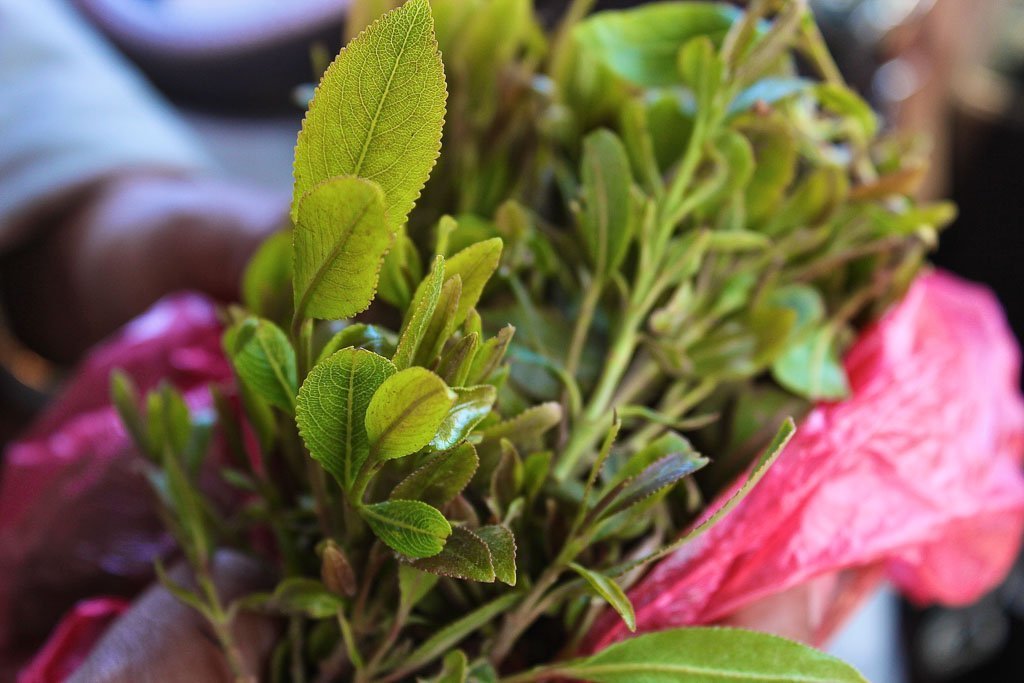
We carried on down into Wadi Dhahr after the snacks and the target practice. A man selling qat even stopped us on our way down. Qat is a leaf popular in Yemen and Somalia, it gives users a mild-euphoric effect.

Dar al Hajar
Dar al Hajar seems to rise up out of the bottom of the wadi like the mirage of a skyscraper. As I got closer I could see that the base was carved out of a giant rock and the palace had been placed atop and adorned in the gingerbread patterns I would see in the near future when I arrived in Old Sana’a. As I made my way in I passed by teenage boys performing traditional tribal war dances outside with swords and jambiyas.
It was a Friday. Friday in Islamic countries is similar to that of Sundays in many Christian-majority countries. It’s a day off and people tend to spend it doing family activities and sharing the day with friends.
It was crowded that day and I ended up the center of attention, I’m probably in hundreds of random people’s photos that day, nearly every kid and family wanted a photo with me after they met me. At one point I was dressed up by a couple of people working at the palace. I was adorned in the robes and silver jewelry alleged to have belonged to one of Imam Yayha’s wives.
Everyone was curious where I was from, most thought I was visiting from Lebanon, Iran, Jordan, Morocco, or Turkey. They were a bit shocked when I’d say the US and even more so when they asked which state and I said Alaska. Most assumed my bloodline was descended from somewhere in the Middle East.

Dar al Hajar, or often referred to as the ‘Rock Palace’ was built in the 1930s as a summer home for the Imam Yahya of Yemen. Inside, near the entrance of the palace was the well they used to collect water from and the kitchen.
The next floors were the wives’ rooms and lounge rooms. I got a lesson in the interesting way Yemenis keep meat cooled during storage in the hot summer months- think of it as ancient refrigeration using shade and gypsum block walls. And then I was introduced to the pinnacle, one of the beautiful architectural designs of Yemen: The Qamaria.
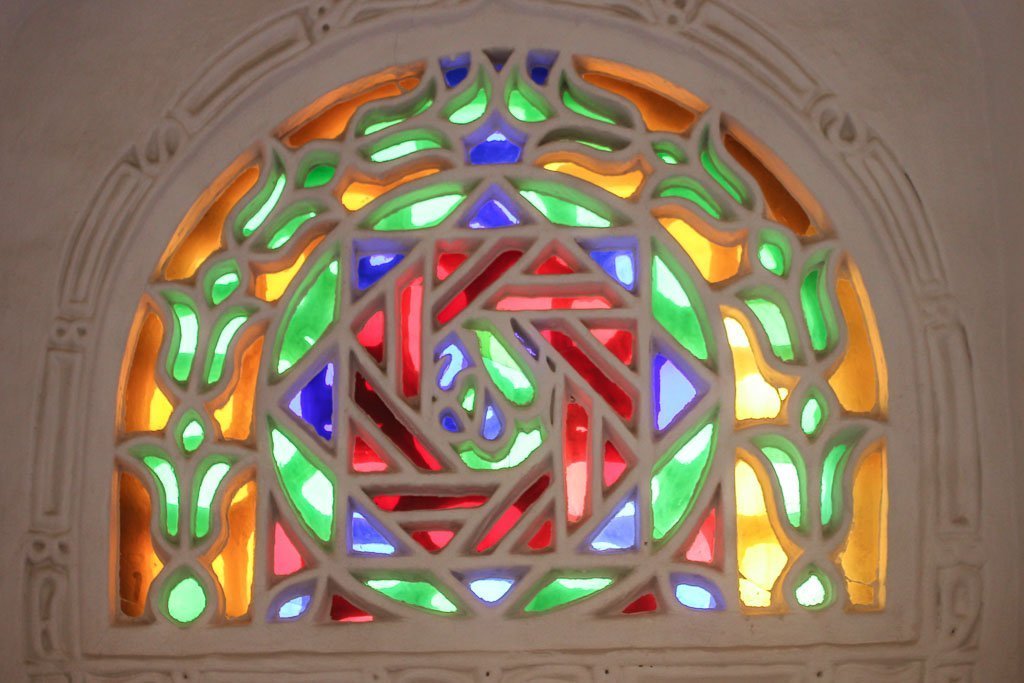
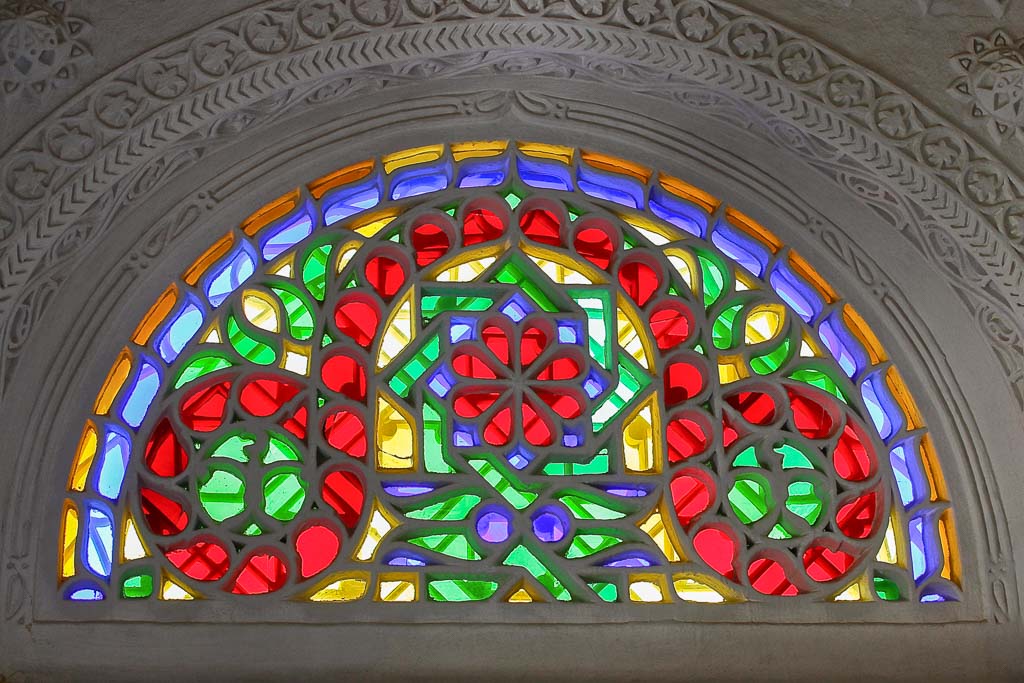
The Qamaria is a window, but not just any regular old window. They consist of intricate designs made of gypsum and then the design is accented with colorful stained glass.
Qamarias are a popular feature of Yemeni architecture and part of what makes the country’s building styles and designs so unique. Not buying and bringing home a Qamaria is one more thing we can add to the I wish-I-would-have List.
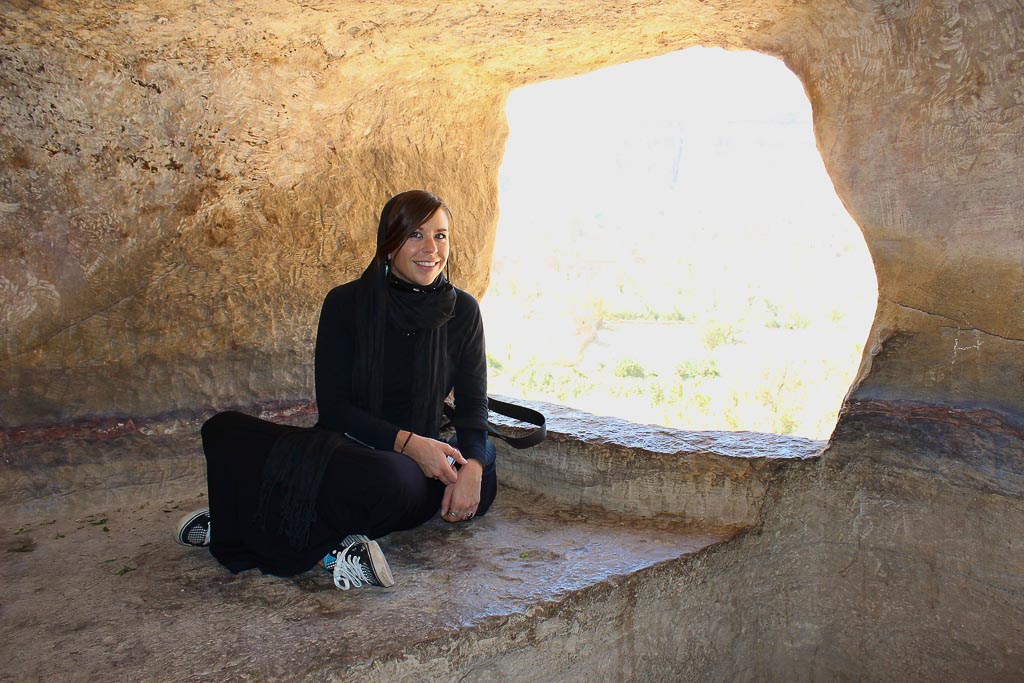
Dar al Hajar was a great introduction to Yemen. Not only was it a historical experience, but I was also able to meet local people and see what a day off in the country was really like.
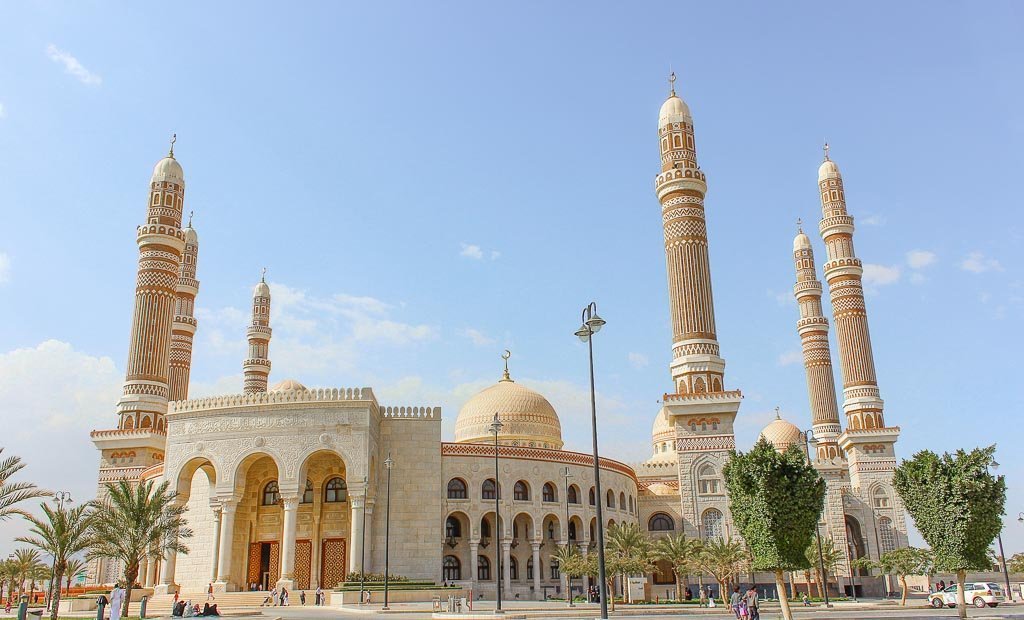
Saleh Mosque
Controversial and stunning. A gross misuse of money, but an almost monument to the city. The Saleh Mosque was constructed on the southern outskirts of Sana’a in 2008 and named after the president at the time- Ali Abdullah Salah.
The hope of the administration was that the mosque would help promote moderate Islam in a country that is so deeply divided, tribe to tribe, and sect to sect. Saleh was the recipient of many a criticism and understandably so. The construction of the mosque didn’t come without tragedy, numerous times minarets collapsed during the building of the mosque resulting in several deaths.
Of course, Saleh was heavily scrutinized for spending $60-million US dollars on a mosque in his name in a country with waning socio-economic issues and spiraling toward unavoidable chaos.
It is irresponsible to spend that sort of money on something so cosmetic when many of your people are malnourished and living vastly below the poverty line. But hey, look all around the world- Politicians do it all over the world to no avail and with no shame, even here in the west. I’m not condoning it, I’m just well aware that every place seems to have their ‘Saleh Mosque’ if you will.
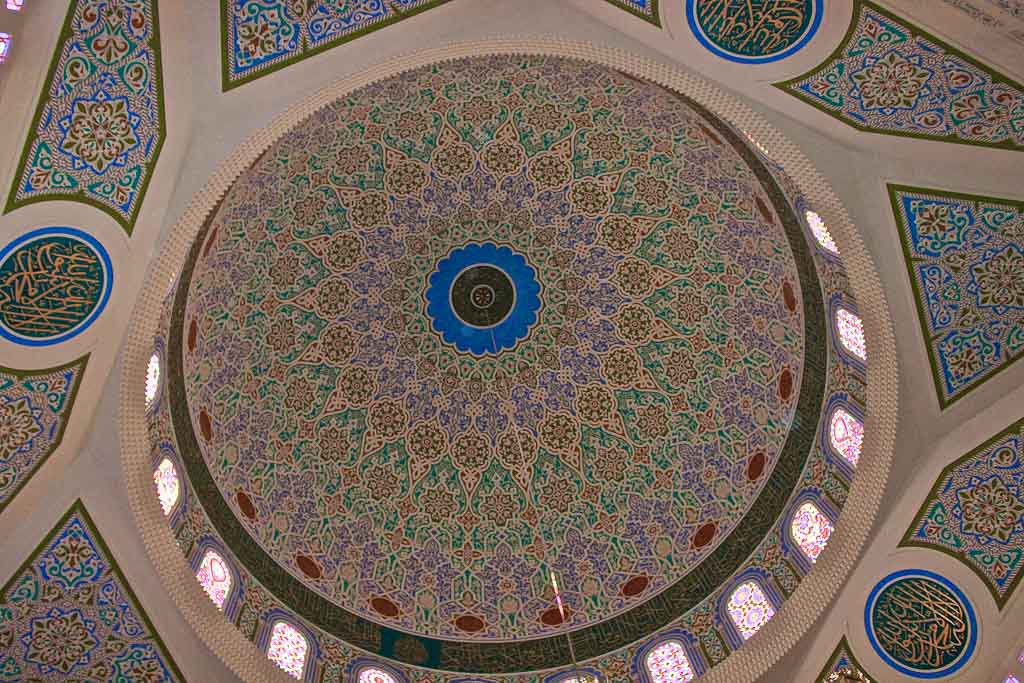
Controversy aside- we can all agree on one thing. The inside of the mosque is one of the most beautiful pieces of artwork I’ve ever seen in my life. It’s massive and once inside reeks of architectural perfection. I’ve since been in numerous mosques spanning Central Asia, Africa, the Middle East, and Southeast Asia and none have rivaled the impression this one left.

Meandering Through Old Sana’a
Beguiling and bemusing is the best way to describe it, Old Sana’a is like nowhere else. I’ve been to several places since that have elements reminiscent of certain aspects of Old Sana’a but nothing quite as enchanting and mysterious. It’s architectural porn really.
Narrow mazes of impossible-to-navigate stone streets, high-rise sun-baked brick homes iced like gingerbread houses with white gypsum and Qamaria windows, hunger inciting smells around every corner, exotic spices and smells emanating from the souks, and bustling with people. And to top it all off, the impressive city has been continuously inhabited for over 2,500 years. Of course, the city’s rich history and long-standing inhabitation have lead it to be named a UNESCO World Heritage Site.
Approaching the Old City I noticed something unusual. It was built up higher above the streets outside around it. Gamal, being the expert guide had an answer. Sana’a can receive heavy rains in the monsoon season.
The city was built in a way to keep the streets from flooding. Instead, the streets below that circle the outer edge of the city will act as a wash and Old Sana’a will be encircled in a temporary moat of rainwater.

Everything I had read leading up to me arriving in Sana’a had me thinking that I’d be walking the streets of Sana’a with Gamal and not see hardly another soul. The media, in their norm- only reporting the most negative aspects of society, made me picture Sana’a as being empty.
I always have envisioned war zones, or as Yemen’s case at my time of visit, ‘teetering on brink of war zone’ as being devoid of people, empty streets, no sign of life. People staying inside homes and peeking out windows, only darting out when they absolutely needed something. This wasn’t the case at all. Sana’a was happening.
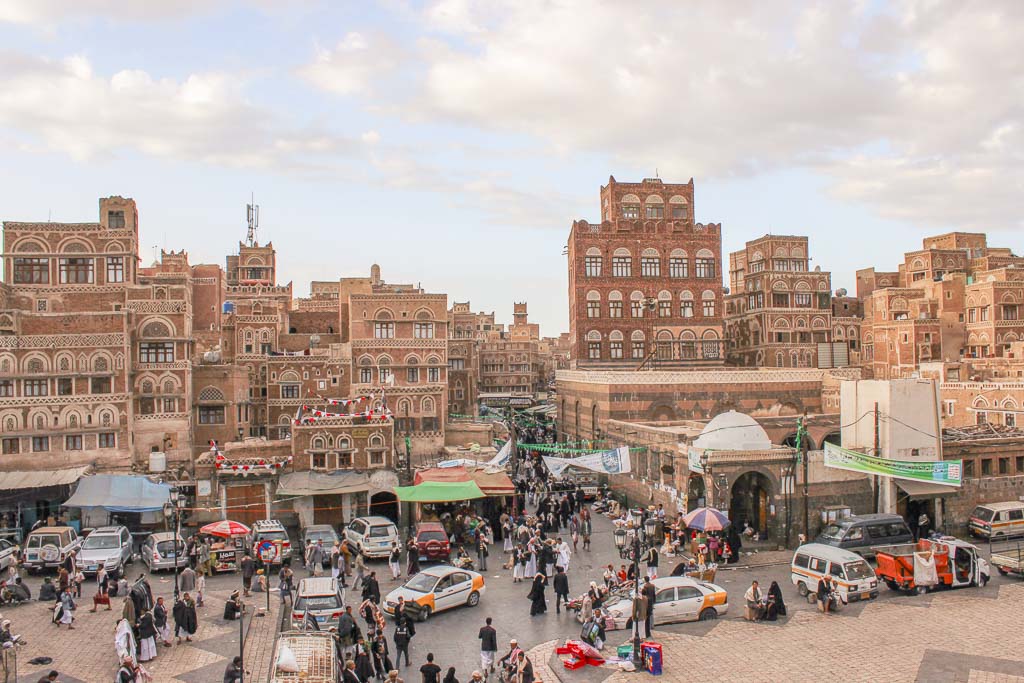
People were at every turn. People grabbing my hands and dropping pistachios, almonds, and raisins into them, grabbing scoops of spices and running them under my nose, women taking me by the arm and throwing Yemeni wedding gowns on me, men glazed eyed with bulging cheeks full of Qat, Gamal welcoming me into teahouse after teahouse for a cup of shai, kids waving hello and women grabbing me by the arm and whirling me into their homes only to whip off their abayas and niqabs to sit and chat with her friends and their new star foreign friend she found in the souk. This was the reality of Sana’a.
Of course, at any moment everyone knows a missile could strike, a grenade could blow off or a bomb could explode. But should people be in constant fear and forced not to live because of it? Sana’a was everything and more than what I envisioned it.
I never even could sense fear or wind of caution. Even though I know that Sana’a is pretty dangerous as of now, I hope that the spirit and life in the Sana’anis are still present.
One of my favorite things about the city was heading to the rooftop of one of Sana’a’s highest buildings to sip some shai as the sun set and the Call to Prayer sang from minarets near and far all over the city. As the Call to Prayer came to a close the city’s night came right back to life. The bustle carried on. Sana’a is Arabian Nights come to life.
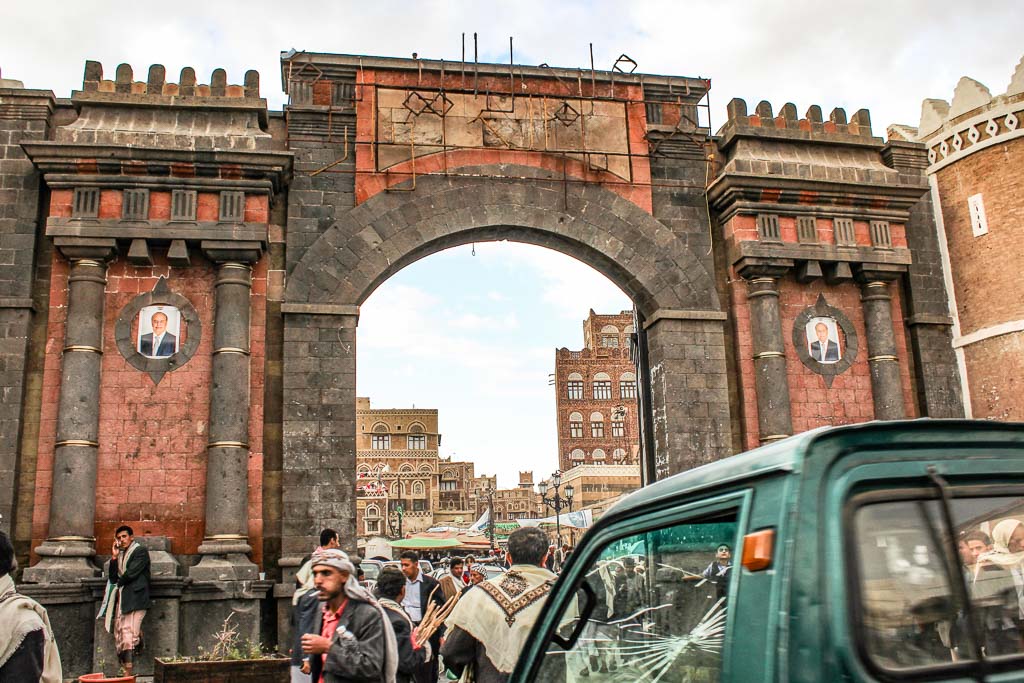
Bab al Yemen
This is the gate to Yemen, giving access to Old Sana’a passing through its over one-thousand-year-old fortified walls. The gate is busy, with people constantly walking and driving in and out.
A woman driving a Landcruiser full of kids laid on her horn to get my attention while the whole car waved at me. She wanted to make sure that I knew they were welcoming me into their city. Gamal even added, “See, Yemen is much more progressive than Saudi Arabia. Women drive here, did you know that?”.
Obviously, Gamal is used to most tourists assuming that some of the restrictions of its neighbors happen here.
The most magical of the Bab al Yemen was still yet to come. Gamal ushered me toward a dark hallway corridor. I could see white gypsum steps going up inside. This was the passage that led atop the Bab al Yemen. There we stood with several other onlookers watching the lively city under that golden light as the sun started to make its escape below the horizon.

The Great Mosque of Sana’a
The Great Mosque of Sana’a is the oldest in Yemen and one of the oldest in the world. It was built sometime estimated between 630 AD and 715 AD.
According to local legend, it is believed that the Prophet Muhammad was involved in the planning and construction of the mosque, although no evidence has been uncovered proving this legend true. One important discovery made was during a 1972 renovation in which the Sana’a Manuscript was discovered, along with several copies of an ancient version of the Quran, and thousands of rare Arabic Manuscripts that are tied to the start of Islam, Sheba’s Palace of Ghamdan, and the Umayyad Period.
The ancient Sana’a Manuscript is the oldest known, intact copy of the Quran. It contains Quran verses that differ from the present-day version.
The mosque is only open to members of the Muslim faith, so I was unable to enter but was able to appreciate it from the outside. Gamal even pushed me up near the entrance and had me stick my head in just to see. The Great Mosque was a pride to Gamal and all Yemenis, after all- it is the location of the oldest copy of the Quran.

Spice Souk
Mountains of colorful spices, nuts, coffee beans, and dried fruits neatly arranged in rows lined the narrow alleyways of the busy market. Every exotic small you could imagine swirled around in the air. Even though I’d traveled extensively through Europe and Asia by this point, I’d never experienced a market quite this interesting or ancient.
Sana’a’s Souk is one of the oldest souks in the world.

What I Ate In Sana’a
With a little influence from neighbors and mountains that sectioned the country off from much of the Arabian Peninsula over the years, Yemen has developed a cuisine distinctly their own.
Lunch is the main meal in Yemen, which made it my favorite. Going into a restaurant at lunchtime was a fun experience. When Gamal and I walked into the first restaurant we ate at, we were brought to a table in the middle of the room, quickly after we were seated we were brought tea and traditional qawa- Yemen’s coffee drink, and one they’re famous for.
Other guests started pouring in, many of the groups with women came in and asked for a private area where the staff brought out portable frames with fabric to block them in. Other families and groups ate out in the open as we did. It was quite interesting watching how the women managed to skirt the food around their niqab and into their mouths without seeing any skin.
Pretty soon our table was inundated with dish after dish after dish. Basically, the way it worked was plates of dips, sauces vegetables, rice and meats came out covered with plastic wrap. Gamal showed me that in Yemen you take a spoon full of the dishes and put them on your own plate and then the dishes are taken to other tables. It’s very communal.
Then the cornerstone of any Yemeni meal came out: The largest flatbread I’d ever seen in my life called malawah. Flatbread is your utensil for eating. You use it to pick up your dips, sauces, veggies, meat, and rice and bring it to your mouth. Flatbread is the mode of transportation in the Yemeni food scene.
There was Salta, Ful Medames, Yogurt, Chili Sauce, Harees, Kabsa, Mandi, Kebab, and Thareed just to name a few. Everything tasted new to me and I loved every bit. Most dishes are spiced with a mixture called Hawaij that includes anise, ginger, cardamom, and fennel. Other important spices in Yemeni cuisine include fenugreek, cumin, coriander, salt, pepper, cilantro, mint, turmeric, and chilis.
Of course, dessert is involved with any lunch. I was served a sweet Bint al-Sahm with the famed Yemeni honey drizzled over it.
Breakfasts and dinners are generally lighter meals and will be centered around a flatbread and tea or kawa. Fatoush, Fattut, and Full are common dishes at both meals. Yogurt with honey is also a popular side. The one difference between the two meals is that breakfast sometimes includes pastries.
Where I Slept In Sana’a

I stayed at a small family ran hotel called the Arabia Felix* that stood right in the heart of Old Sana’a. I had a room on the fifth floor where I had views out over the city. It’s a popular place for traveling Yemenis and backpacker types (the few that make it here, that is).
Sure, there are bigger hotels outside the Old City with armed guards, but I rather stay in something a little more Yemeni and in the middle of it all.
Of course, come sun up, there was no more sleeping as the Call to Prayer echoed throughout the city and into the room. But at the same time, there is something magical and enchanting about the Call to Prayer ringing out over the city and having the sun glimmering through the colorful glass of the Qamarias above my windows. I remember getting up, cracking my window open, and just sitting in the frame watching the city wake up.
*The name Arabia Felix is a nickname that was given to the country by the Romans in ancient times meaning ‘Happy Arabia’.


The Land Of Milk & Honey
The Land of Milk and Honey is one of Yemen’s nicknames, given by Noah. Yemen is widely known to produce the finest honey in the world. The Hadhramaut region in particular produces the best of the best.
The people of Yemen have been keeping bees for hundreds of years. Of course, before I departed the country I stocked up on some Hadhramaut honey before I left the country. I also packed a large jar of Socotri honey from the island back home as well.
Ever Wonder Where Mocha Comes From?
Along Yemen’s short Red Sea coast sits the port of Mocha. Most people in the west know Mocha as a chocolatey coffee drink slung in most coffee shops. This isn’t the real Mocha in the traditional sense of the name.
Mocha is actually a particular bean native to the fertile region surrounding the port. Mocha beans became famous throughout the ancient world for their naturally warm, chocolatey tones. At one point Yemen was a massive exporter of coffee beans along the spice trade route.
Of course I had to try some real Mocha and Yemeni coffee, or kawa as they call it.
What I Thought of The Life of Yemen’s Backbone: Women
Yemen is an interesting country for women, particularly the cities. Women really are walking this tight rope balancing act of old and new ways. More and more there is a push for them to be educated, there is a push for them to work, but also there are societal expectations nudging them to marry young (typically to be arranged by parents) and have several children (four children is average).
In some ways, the expectation to go to school, succeed, have a career, get married, become a mother, and take care of the home, made the lives of women not feel that different from home, while at the same time Yemeni women are subject to arranged marriages, far fewer rights than women in western countries, social pressure to wear a concealing cloak of black, among many other injustices that aren’t the norm in western countries that we take for granted, made Yemen feel light-years away.
The general treatment is not perfect by any means. In many parts of Yemen, women are not treated well. They are married off as child brides, abused, tortured, and more.
As far as women’s dress in Yemen it was very conservative in 2014. When I was visiting there was no law requiring what women had to wear, but the societal norm was the black abaya, paired with the niqab (the face covering veil), leaving eyes as the one visible human flesh.
As Al Qaeda made its presence known throughout the country the colorful abayas traditionally worn by women were soon replaced with the cloak of solid black and the use of the niqab began. Women didn’t necessarily want to give up their traditional dress, but in avoidance of potential attacks on them, many chose to conform. You still see women nipping out for quick errands near to their homes in the traditional Sana’ani Curtains.
Even with the sea of solid black, you see around the city, women have still managed to accessorize their plain black uniforms. You see abayas worn around and being sold in shops adorned with intricate gold and rhinestone designs.
Traveling as a female in Yemen opened me up to a unique opportunity that visiting men never get to see: what the women of Yemen look like underneath the abaya. Once inside homes and into the female quarters of the house, all the layers come off. What they wear underneath is surprisingly western- leggings, t-shirts, jeans, cute dresses, jewelry, and perfectly done makeup are not unusual.
You can even read this article here, where a Yemeni woman is interviewed on her feelings toward the niqab. Another interview to check out is this one by Vice, where women are asked about the Niqab among other things. Many women will tell you that they find the full covering including the niqab to give them a sense of reassuring anonymity.
I personally chose to wear a long sleeved flowing black dress paired with a black scarf worn like a hijab. When I was planning my trip with the help of the lovely crew at Socotra Eco Tours, I was told to dress conservatively, that covering hair was a good idea but not required, and that a key element was to look enough different that your disguise didn’t backfire on you.
As a tourist you’ll probably be out doing things, activities, and visiting areas where Muslim women may not be allowed or will be chastised for partaking in. Being a foreign female in Yemen and much of the Islamic world allows you a unique chance to see many things local women aren’t allowed to, and others men would never be able to, it’s as if the foreign female is its own gender.
*Note: Dress on the island of Socotra is more liberal than in the mainland of Yemen, although local women tend to dress conservatively. Colorful abayas are more common, although all black is still seen. Islanders are more accustomed to seeing foreigners and western-style dress.
I actually didn’t mind wearing the abaya and hijab. I found that I stayed cool with the breeze whirling the layers of fabric. It was easy enough to just whip my hair back in a bun in the morning and ignore it all day with it covered by my headscarf.
I didn’t feel self-conscious about how I looked in my loose-fitting dress and abaya, it hides everything. While I wouldn’t want to be forced to dress a certain way whether by law or by society if women want and choose to wear this conservative design, more power to them.
Plus let’s face it even in the west due to school regulations, the fashion industry, and societal pressure, women and girls are expected to dress in certain ways. It’s all part of the greater plot to keep women down. In the US when female rape victims come forward the first thing they’re asked of course is, “what were you wearing?” Because these nimrods still haven’t figured out that it isn’t about what you were wearing, it’s about control and power. I’ve been catcalled, hassled, yelled at, and inappropriately grabbed and touched while out back home all the while some of these events happened while being solidly covered from my toes to my collarbones.
*I know you’ve probably noticed that I have no photos of Yemeni women. Many are not comfortable with having a photo taken by a stranger and I didn’t feel comfortable just snapping photos of them.
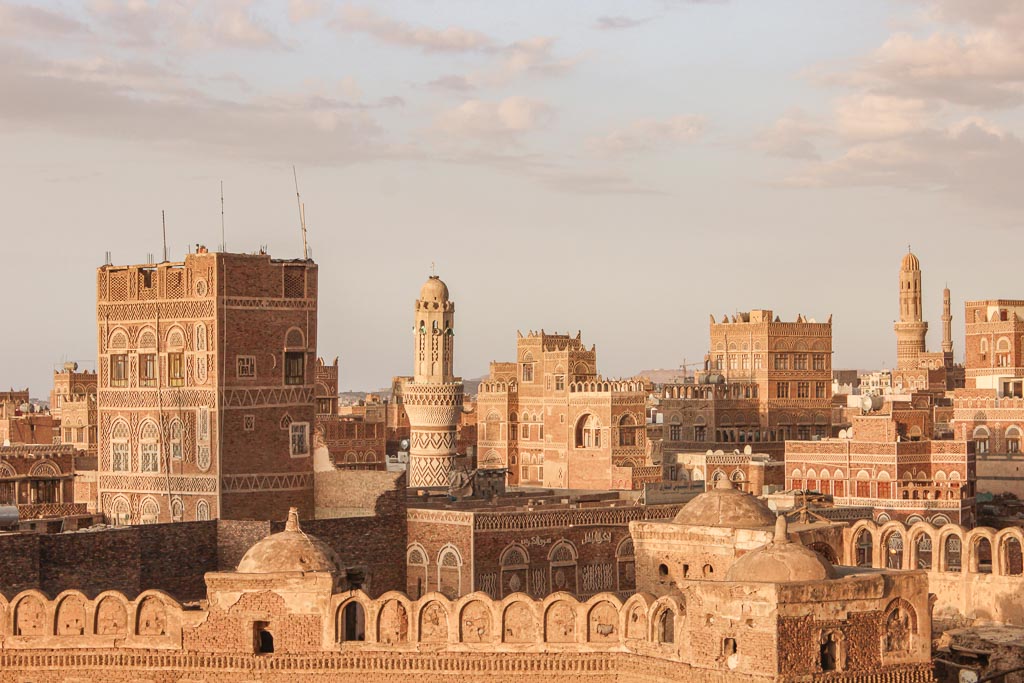
What Was It Like To Travel To Sana’a As A Solo Female
I decided to visit Sana’a on my own, but the reason for this was that no one would join me. This wasn’t my first trip or even my first travels to a difficult destination.
I didn’t have any issues as a solo female traveling in Sana’a, Socotra, or anywhere else in Yemen. But it’s worth noting that at the time (and still now in 2020) that you can only get a visa with the help of a fixer or guide, so I was typically accompanied by Gamal while in mainland Yemen.
My Overall Impression of Sana’a, Yemen

I loved my entirely-too-short time on Yemen’s mainland visiting Sana’a, Wadi Dhahr, and Dar al Hajar. I am so happy that I did get to travel to Yemen and have the opportunity to see it. One of the only regrets I’ve ever had has been not spending more time here (we could also throw in there that I regret not knowing how to properly use my DSLR camera when I was in Yemen as well, but that’s a whole different story in its own).
It’s a unique country, steeped in ancient history, contains some of the most welcoming and friendly people, and is an all too often forgotten corner of the world. The poverty, the struggle, the difficult lives people lead in Yemen are apparent, especially when you compare it to its Arabian Peninsula neighbors. Yemen is more on par economically with some of its East African cousins just across the narrow Red Sea.
Yemen is home to so many important locations in all of human history. Just pick up a book on Yemen’s history and start reading, it really is one of the most fascinating countries. I think if people knew what was in Yemen and were openly exposed to what is being done to the country and how regardless of religion many of the sites being destroyed in missile strikes and blown up by fundamentalist organizations are actually important in all of human history.
The oldest known copy of the Quran is here, Muslim or not which is an important document in human history. Sana’a is one of the oldest continuously inhabited cities in the world, up there with Jericho, Argos, and Damascus in antiquity. Why no one in the west cares and even in some cases are completely unaware of what’s being done to Yemen is baffling yet quite apparent: Yemen is poor and Yemen doesn’t have known oil reserves.
I can’t wait for the day that the war is over or at least stifled to the point that help can get in. This is one of the most fascinating countries I’ve visited and I only was able to see a small sliver of it. I would love to one day go back.
You probably have noticed I didn’t include any information on my trip to Socotra in this post. The two areas of the country I visited were Sana’a and Socotra. I ultimately decided to split them into two different posts because they are so vastly different.
Unfortunately, as of 2020, traveling to Sana’a isn’t exactly possible, however, the eastern part of the country including the Hadhramaut and al Mahrah region is, though it comes with risks and is realistically only possible with the help of local fixers.
Donate to Those Affected by the Crisis in Yemen
If you want to donate any money to Yemen’s people to help with the dark humanitarian crisis currently engulfing the country you can give money to:
- Zakat Foundation: Provides emergency relief and food distribution in several countries including Yemen.
- International Rescue Committee: Helps to bring safety, education, power, and health services to some of the world’s most devastating humanitarian disasters including Yemen.
- Baitulmaal AHED: Organization that works in Yemen as well as all over the world to help bring poverty and disaster relief.
- Islamic Relief: Working to alleviate hunger, illiteracy, and disease in Yemen and globally.
- Solidarios sin Fronteras: Spanish organization helping bring relief, food, water, and reconstruction projects to Yemen as well as Socotra.
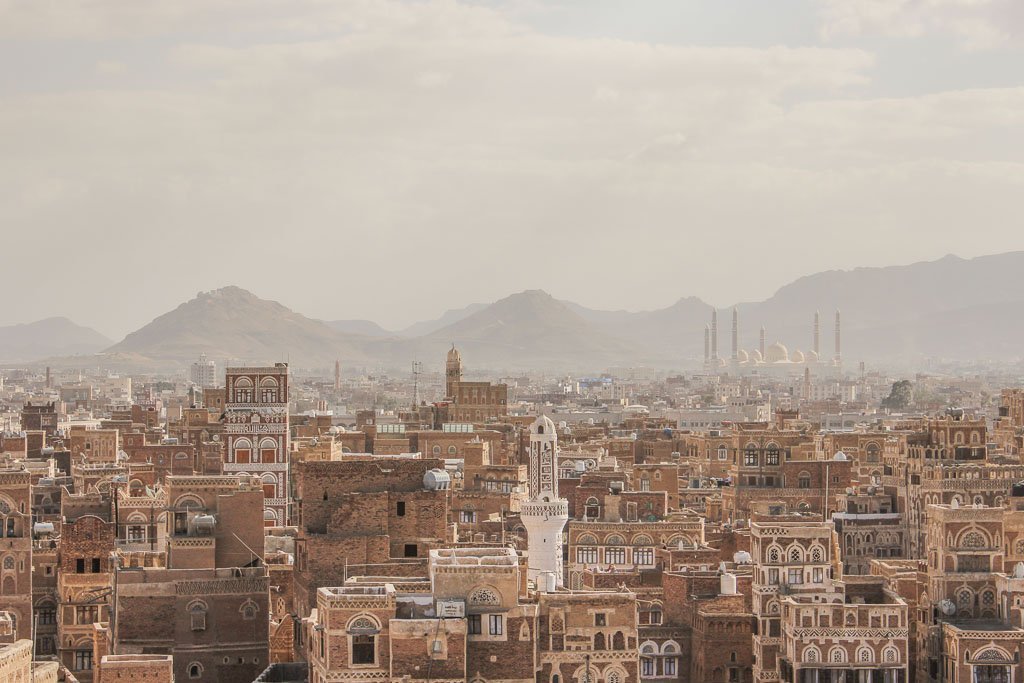



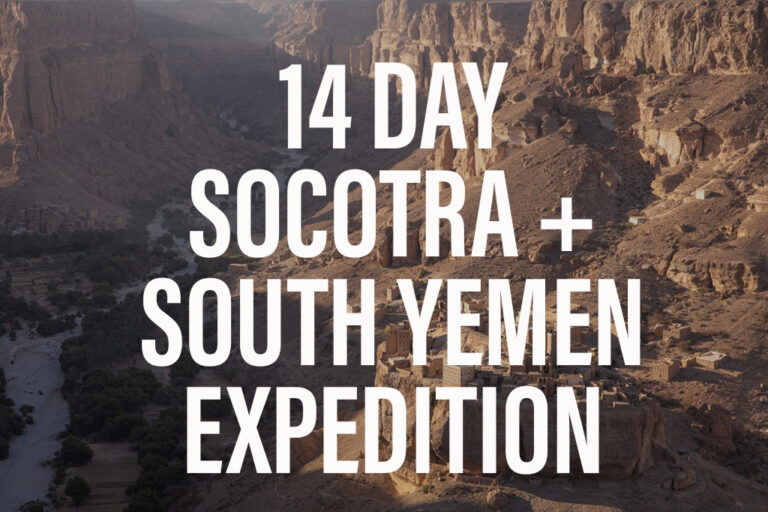





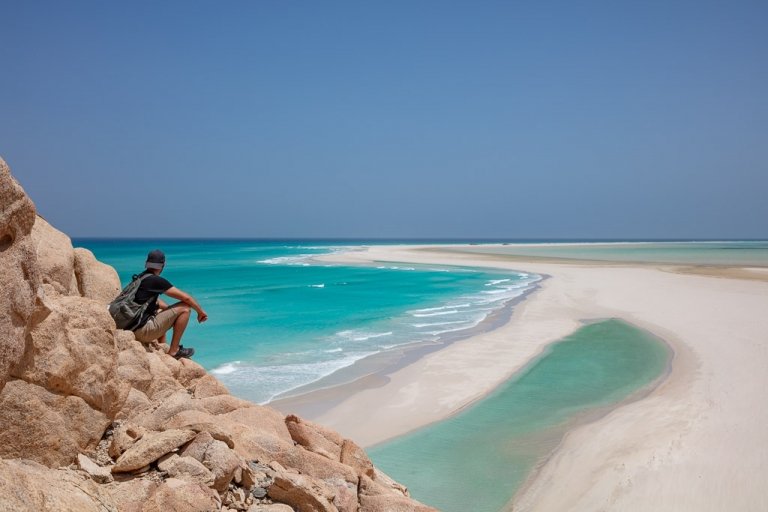
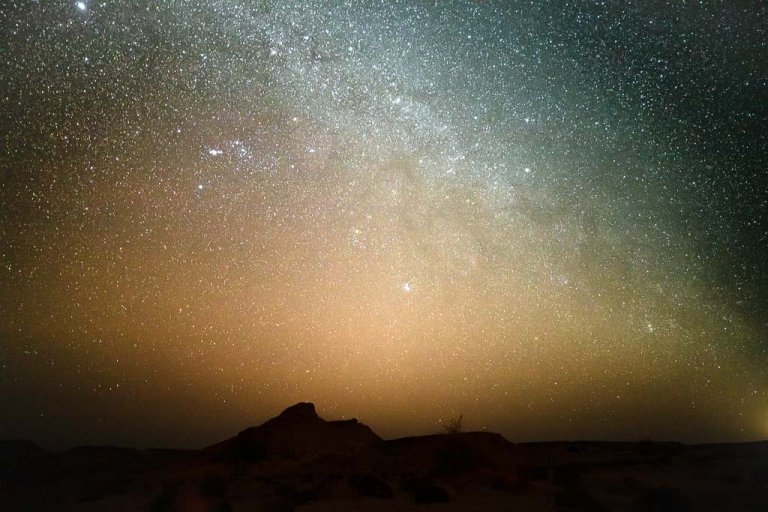


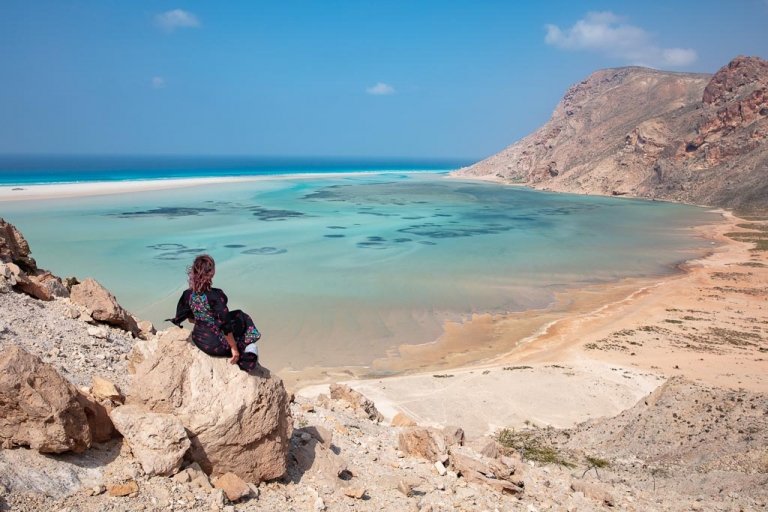
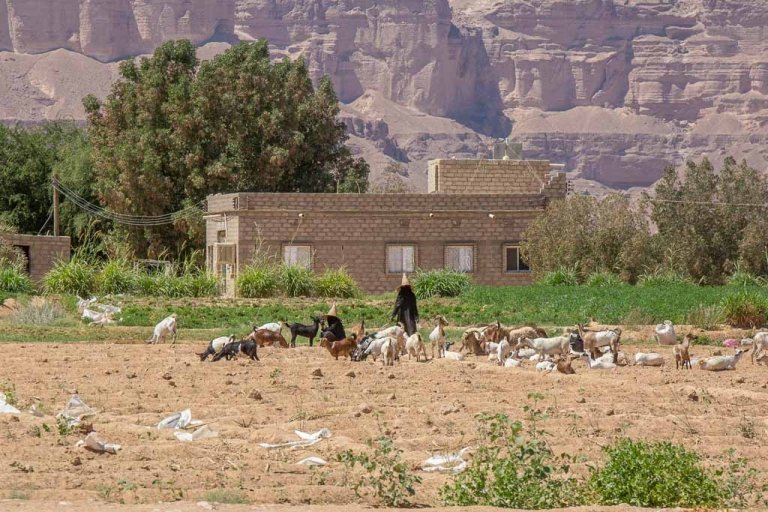


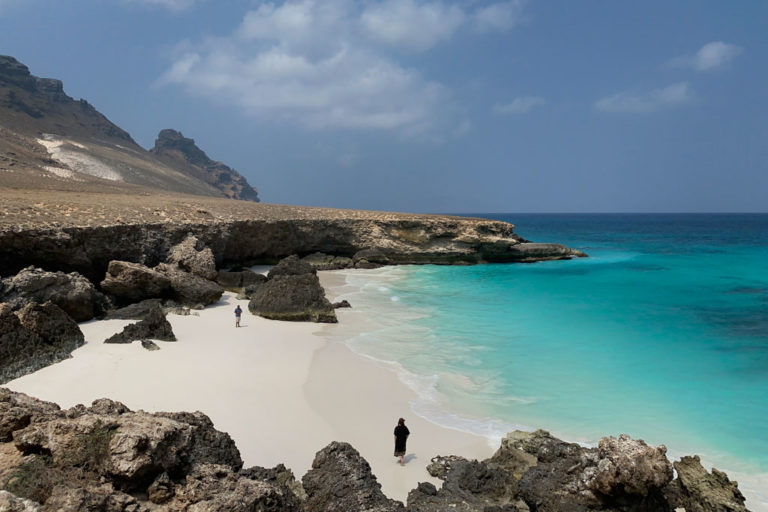



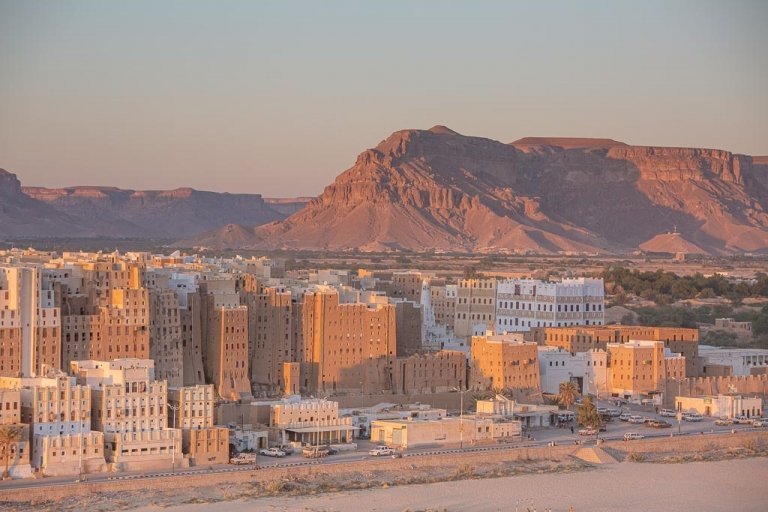


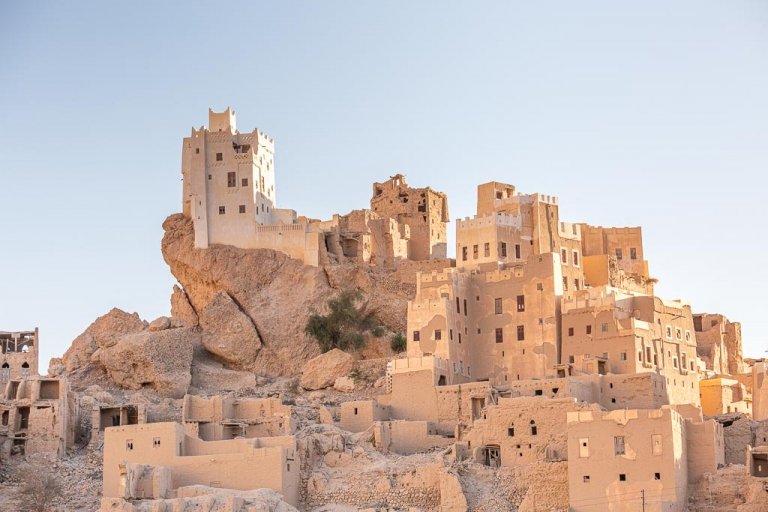
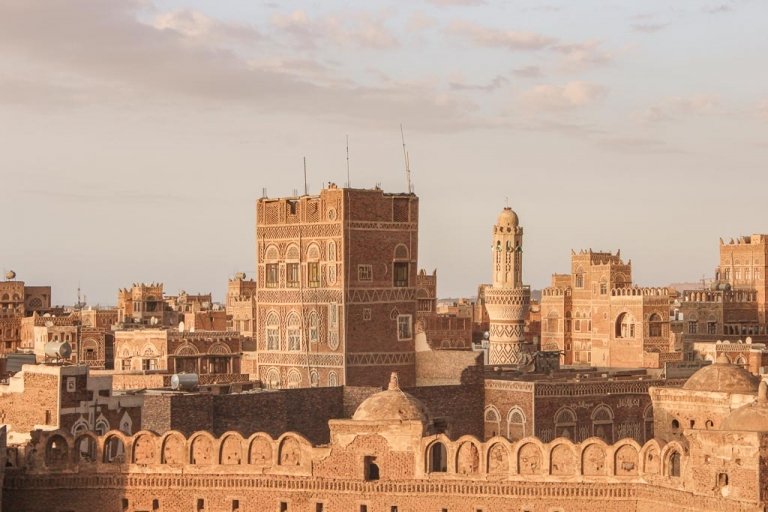


Hi. Nicole Thanks for amazing story. I wish you were able to visit Hudaydah it is great city to the what of Yemen on the coast of Red Sea
Hello Nicole,
I plan to go to Yemen this year. Can you please contact me, Have some questions.
I really want to go but am very hesitant
Hi Karima,
I’ve sent you an email
Hi,
I’am represent the Villas&Golfe magazine. We want make a editorial work about Sana. For that, we need photos, in hight Resolution. Can you send us?
Thanks
maria cruz
jornalist
Hi Maria,
I just sent you an email in regards to Sana’a photos.
Hi Nicole,
Just stumbled upon your article and loved it. It was beautifully written and I loved reading about my fatherland ❤️ My father’s side of the family live in Aden and Sana’a and I have not been to visit since 2003. I miss Yemen so much and hopefully will be able to visit in the near future ❤️
Nadia xx
Hey Nadia,
Thank you for reading! I hope you get back one day. I have not gotten to Aden yet, but one day I hope to.
Hi! This is breathtaking. I’ve been thinking about Yemen for a while and I’m impressed (motivated even more I guess) about your solo trip. Thanks for sharing your experiences and thoughts about this enygmatic country!
Hey Juan, thanks! Yemen was amazing, I really would love to travel the mainland again eventually and see more. Hope you make it there one of these days
Thank you for your kind words about my home country of Yemen. I miss very much my family and Sana’a. Insha’allah peace returns to my brothers and sisters and the country I miss so much
Hi Haidar,
I hope for the same and I hope your family is okay there
Hello Nicole! I’m so pleased I found this post and so happy you were able to visit Yemen and have an amazing time. I have unfortunately never been, but my father and his family are from Aden in the south of Yemen and I have taken an interest in learning more about Yemen through my Master’s programme. As someone who constantly sees media and reads about the horrific atrocities taking place in Yemen today, it is refreshing to see a positive account from a fellow American traveller to remind us all that there is still hope and Yemen will always be a beautiful country full of culture and history. I hope you can return one day and visit Aden!
Hi Yasmin,
I hope you can get there one day soon and see where your family came from. Yemen is fascinating and it’s so sad what is happening there. I wish I’d have taken the chance to explore more when I went in 2014 since things were a lot better than they are currently (though they weren’t too great when I was there and things seemed to deteriorate quickly). It’s definitely a special place
I would love to do this one day! I have massive respect for you! You’re a true adventure traveller! 😀
I hope you make it there one day, it’s a beautiful place!
I hope you came back to Yemen . because there are a lot of places you have not visited yet … & I think you are so brave , also you have the courage ….. we are so proud of you .
I hope you came back to Yemen . because there are a lot of places you have not visited yet … & I think you are so brave , also you have the courage ….. we are so proud of you .
I do as well, Yemen is an amazing place and I miss it a lot.